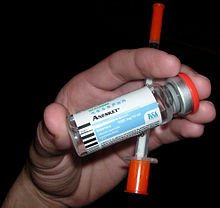Ketamine is a drug used in human and veterinary medicine. Its hydrochloride salt is sold as Ketanest, Ketaset, and Ketalar.Pharmacologically, ketamine is classified as an NMDA receptor antagonist.[2] At high, fully anesthetic level doses, ketamine has also been found to bind to opioid μ receptors type 2 in cultured human neuroblastoma cells – however, without agonist activity[3] – and tosigma receptors in rats.[4] Also, ketamine interacts with muscarinic receptors, descending monoaminergic pain pathways and voltage-gated calcium channels.[5] Like other drugs of this class such as tiletamine and phencyclidine (PCP), it induces a state referred to as "dissociative anesthesia"[6] and is used as a recreational drug.
Ketamine has a wide range of effects in humans, including analgesia, anesthesia, hallucinations, elevated blood pressure, andbronchodilation.[7] Ketamine is primarily used for the induction and maintenance of general anesthesia, usually in combination with a sedative. Other uses include sedation in intensive care, analgesia (particularly in emergency medicine), and treatment ofbronchospasm. It has been shown to be effective in treating depression in patients with bipolar disorder who have not responded to other anti-depressants.[8] In persons with major depressive disorder, it produces a rapid antidepressant effect, acting within two hours as opposed to the several weeks taken by typical antidepressants to work.[9] It is also a popular anesthetic in veterinary medicine.
Ketamine is a chiral compound. Most pharmaceutical preparations of ketamine are racemic; however, some brands reportedly have (mostly undocumented) differences in enantiomeric proportions. The more active enantiomer, (S)-ketamine, is also available for medical use under the brand name Ketanest S.[10]
Ketamine is a core medicine in the World Health Organization's "Essential Drugs List", a list of minimum medical needs for a basichealthcare system.[11]
Contents[hide] |
[edit]Medicinal use
Indications for use as an anaesthetic:
- Pediatric anesthesia (as the sole anesthetic for minor procedures or as an induction agent followed by muscle relaxant and endotracheal intubation);
- Asthmatics or patients with chronic obstructive airway disease;
- As part of a cream, gel, or liquid for topical
application for nerve pain — the most common mixture is 10% ketoprofen, 5%Lidocaine, and 10% ketamine. Other ingredients found useful by pain specialists and their patients as well as the compounding pharmacists who make the topical mixtures include amitriptyline, cyclobenzaprine, clonidine, trama

No comments:
Post a Comment